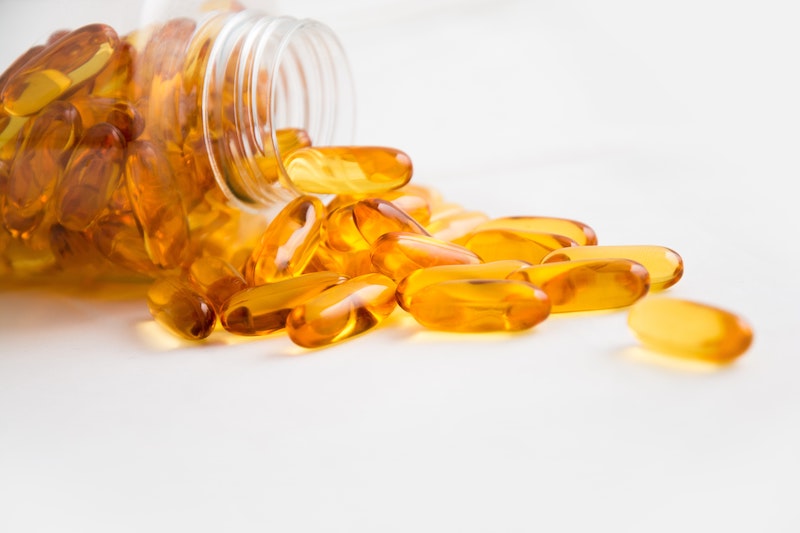Fibro Fix Blog — cardiovascular

The “Eyes” Have It: Fish Oil for Eye Health 0
These days, you can’t pick up a health magazine or nutrition book and not find someone singing the praises of fish oil. From supporting cardiovascular health and a normal inflammatory response, to supporting healthy brain function and keeping the skin supple and hydrated, there’s certainly no shortage of feathers in fish oil’s cap. Eating oily fish as a whole food is a great option, since it comes with complete protein and other helpful nutrients, but many of the benefits that come from eating fish are primarily due to the omega-3 fatty acids found in the fat – specifically, eicosapentaenoic acid and docosahexaenoic acid, EPA and DHA for short.
Fish oil is well known for helping conditions associated with the body’s natural inflammatory process. (Think of good quality fats as oil being added to rusty machine parts to help them work more smoothly.) One of the lesser-known properties of fish oil is that it may be good for eye health. Occasional inflammation in the eyes may interfere with the production of tears and other eye lubricants, both in quantity and chemical composition. Tears aren’t just water and salt; they contain an oily layer, which prevents them from evaporating too quickly and leaving someone with excessively dry eyes.
Dry eye syndrome, or “dry eyes,” has been the unfortunate victim of somewhat comical ads for prescription and over-the-counter eye drops and artificial tear products. To people living with the condition, however, it’s no laughing matter. It can cause mild to moderate discomfort, and more severe cases may interfere with work and reduce overall quality of life. Studies support a role for EPA and DHA in aiding this condition.
The incidence of dry eyes is lower in populations consuming large amounts of omega-3 fats, and is higher in populations with a high omega-6 to omega-3 ratio. In one trial that investigated the effects of fish oil supplementation in individuals with dry eyes, compared to placebo, subjects taking fish oil (1245mg EPA and 540mg DHA per day) for 12 weeks experienced small but notable improvements in subjective eye pain and dry sensation. Aside from dietary supplementation, topical application of omega-3 fatty acids via eye drops may be another way to introduce these helpful compounds into the eyes. Experiments employing mouse models of dry eye indicate that eye drops containing a mixture of omega-3s and hyaluronic acid improved corneal function and decreased inflammation and oxidative stress markers on the surface of the eyes.
Another eye health concern for which fatty fish consumption or fish oil supplementation may be beneficial is age-related macular degeneration (AMD). Compared to healthy controls without AMD, AMD patients consume significantly lower amounts of oily fish. Amounts of EPA and DHA measured in blood and the cell membranes of red blood cells (a good way to assess body levels of these fats) showed that higher amounts of these fats in the blood and cell membranes were associated with significantly lower risk for AMD, independent of potentially confounding factors, such as high triglycerides, hypertension, and family history of AMD.
Okay, sounds great! But what if you don’t like fish? Are you doomed to the adult equivalent of when you were forced to choke down soggy, overcooked Brussels sprouts at the dinner table as a kid? Do you have to eat fish to get these benefits? No: fish oil capsules to the rescue! But what about those “fishy burps” that scare people away from taking fish oil supplements? Fortunately, many high-quality fish oils are now available that are designed to reduce the risk of the fishy flavor “repeating” on you.
For vegetarians and vegans, who may find it difficult to get adequate EPA and DHA from the selection of foods available to them, the omega-3 fat, alpha-linolenic acid (ALA, found in flax, chia, and walnuts) has also been shown to be beneficial in animal models of dry eye. However, because many people do not efficiently convert ALA into the more potent EPA and DHA, it may be best to prefer eating fish or taking fish oil, but if those are not options, plant-based omega-3s are still a good choice.
Sources
- Liu A, Ji J. Omega-3 Essential Fatty Acids Therapy for Dry Eye Syndrome: A Meta-Analysis of Randomized Controlled Studies. Medical Science Monitor: International Medical Journal of Experimental and Clinical Research. 2014;20:1583-1589.
- Miljanović B, Trivedi KA, Reza Dana M, Gilbard JP, Buring JE, Schaumberg DA. The relationship between dietary n-3 and n-6 fatty acids and clinically diagnosed dry eye syndrome in women. The American journal of clinical nutrition. 2005;82(4):887-893.
- Kawakita T, Kawabata F, Tsuji T, et al. Effects of dietary supplementation with fish oil on dry eye syndrome subjects: randomized controlled trial. Biomed Res. 2013;34(5):215-20.
- Merle BM, Benlian P, Puche N, et al. Circulating omega-3 Fatty acids and neovascular age-related macular degeneration. Invest Ophthalmol Vis Sci. 2014 Mar 28;55(3):2010-9.
- David Brady
- Tags: cardiovascular dry eyes eye health fish oil inflammation omega-3 fatty acids

WATERMELON – A SUMMERTIME STAPLE 0
Summertime picnics and holiday celebrations would hardly be complete without watermelon. But this brightly colored perennial favorite fruit offers up more than a juicy, thirst-quenching snack in hot weather. Its potential health benefits give it a welcome place at the table.
It is well known that women’s risk for cardiovascular events increases after menopause. Compounds in watermelon may help to improve blood vessel elasticity in this susceptible population, possibly resulting in favorable effects on blood pressure. The effects of watermelon on cardiovascular health are likely due to the fruit’s relatively high content of citrulline, an amino acid that serves as a metabolic precursor to arginine. (In fact, citrulline was first isolated from watermelon, and the compound takes its name from the plant’s botanical name, Citrullus lanatus.) Arginine is a key factor in the production of nitric oxide, which is a vasodilator—meaning, it helps relax the blood vessels, which may allow blood to flow more smoothly. Studies in post-menopausal women and obese adults with hypertension and pre-hypertension have shown that compounds extracted from watermelon help to moderately lower blood pressure. Because of the way the body metabolizes arginine, consuming foods rich in citrulline may be an even more effective way to raise arginine levels in the body than by consuming arginine directly.
The benefits of watermelon compounds on the cardiovascular system make watermelon a nice addition to post-workout recovery for athletes. Fresh as well as pasteurized watermelon juice were shown to have helpful effects on muscle soreness in healthy young men 24 hours after a maximum effort test on a bicycle ergometer.
Watermelon is good source of the antioxidant lycopene, also found in other red/pink fruits and vegetables, such as tomatoes and guava. In a study of healthy adults, supplementation with watermelon juice resulted in significant increases to plasma lycopene, compared to no supplementation. It’s a nice coincidence that watermelon—a summertime staple—is so rich in lycopene since lycopene may be protective against UV-induced photo-damage to the skin. In other words, to a certain degree, watermelon might be nature’s sunscreen!
A cup of watermelon (152g) provides 21% of the daily value (DV) for vitamin C, and 17% of the DV for vitamin A (as beta-carotene). The natural sweetness of watermelon might make those concerned about their sugar intake refrain from this delicious summer treat. However, a one-cup serving of watermelon has just 11g of carbohydrate. Compare that to a large bagel, weighing 131g (less than the watermelon), which delivers a whopping 70g of carbohydrate. Moreover, while the glycemic index of watermelon is relatively high, the glycemic load is quite low. After all, it’s not called watermelon for nothing: of the 152g by weight, 139g are water!
The peppery bite of bitter greens, such as arugula, and the saltiness of cubed feta cheese, make a classic salad to complement the sweetness of watermelon. And the bright pink flesh of a watermelon isn’t the only edible part. Nose-to-tail cooking doesn’t apply just to animal foods; you can use all parts of a watermelon in culinary applications. You can certainly compost the rind and seeds, but there are other ways to put these underappreciated parts to use. Pickled watermelon rind is a great way to use something that is typically discarded. In fact, the rind contains even more citrulline than the pink flesh, and more of other helpful phytochemicals as well.
And don’t forget about the seeds! Watermelon seeds are good for more than spitting out onto the grass at family picnics. Although we don’t typically think of eating them, they’re a good source of natural fats, and they’re high in magnesium, phosphorus, zinc, and manganese.
Consider these recipes for new ways to enjoy watermelon:
- Arugula, Watermelon and Feta Salad
- Watermelon and Tomato Gazpacho
- Watermelon Coconut Cooler
- Watermelon Salad with Tomatoes, Goat Cheese and Basil
And a couple for the rind (feel free to use less sugar, or better yet, use xylitol instead):
Sources
- Figueroa A, Wong A, Hooshmand S, Sanchez-Gonzalez MA. Effects of watermelon supplementation on arterial stiffness and wave reflection amplitude in postmenopausal women. Menopause. 2013 May;20(5):573-7.
- Edwards AJ et al. Consumption of watermelon juice increases plasma concentrations of lycopene and beta-carotene in humans. J Nutr. 2003 Apr;133(4):1043-50.
- Tarazona-Díaz MP, Alacid F, Carrasco M, Martínez I, Aguayo E. Watermelon juice: potential functional drink for sore muscle relief in athletes. J Agric Food Chem. 2013 Aug 7;61(31):7522-8.
- Tarazona-Díaz MP, Viegas J, Moldao-Martins M, Aguayo E. Bioactive compounds from flesh and by-product of fresh-cut watermelon cultivars. J Sci Food Agric. 2011 Mar 30;91(5):805-12.
- Boris Revsin
- Tags: Arginine athletes cardiovascular health lycopene nutrition summer watermelon Watermelon seeds wellness and prevention workout
